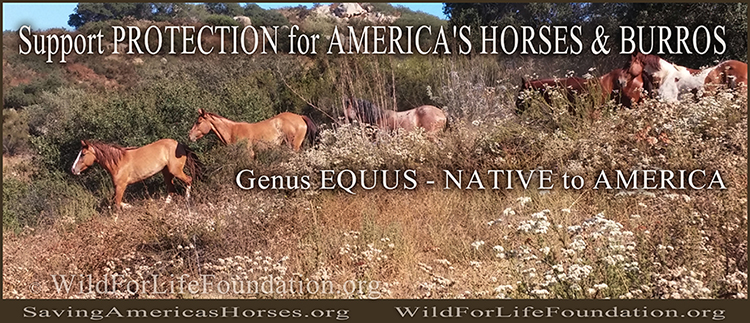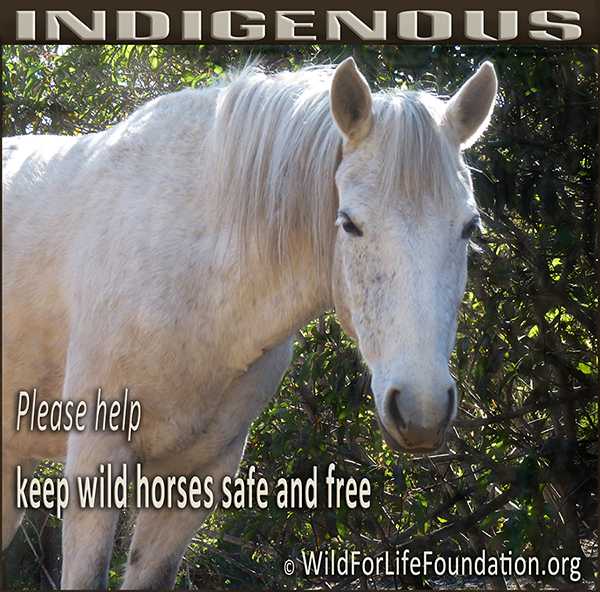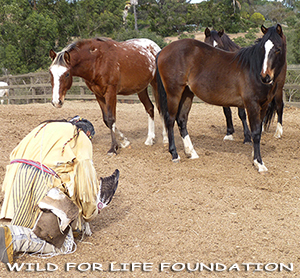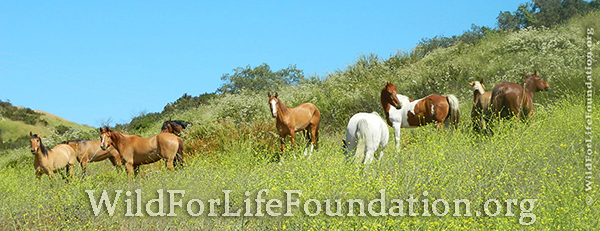|
|
|
Living History and Preservation |
Horses Wild and Free |
The Indigenous Legacy of America's Horses

The History of the America's Wild Horses:
Through our history books we have learned that a variety of mixed breed DOMESTICATED horses were brought into North America by the Spanish, and that some escaped horses from those expeditions survived in the wild across parts of America. In today's world we oftentime hear the BLM and other groups refer to the horses that continue to survive in the wild as "feral". As such they are then erroneously regarded as intrusive, exotic animals. However as E. caballus, we have since learned that they are not feral after all.
A 2008 report by *Jay F. Kirkpatrick, Ph.D. and Patricia M. Fazio, Ph.D. brings to light many of these facts, as well as molecular biology and studies based in mitochondrial DNA (mtDNA) that prove E. caballus originated approximately 1.7 million years ago in North America and that E. caballus is genetically equivalent to the modern day horse.
Jay F. Kirkpatrick, and Patricia M. Fazio have stated, "Based on fossil records, genus equus originated in North America about 4 million years ago and spread to Eurasia by crossing the Bering land bridge 2 to 3 million years ago. Following that original emigration, there were additional westward migrations to Asia and return migrations back to North America, as well as several extinctions of Equus species in North America."
"The wild horse in the United States is generally labeled non-native by most federal and state agencies dealing with wildlife management, whose legal mandate is usually to protect native wildlife and prevent non-native species from having ecologically harmful effects. But the two key elements for defining an animal as a native species are where it originated and whether or not it coevolved with its habitat. E. caballus can lay claim to doing both in North America. So a good argument can be made that it, too, should enjoy protection as a form of native wildlife."
| * Jay F. Kirkpatrick earned his Ph.D. in reproductive physiology from the College of Veterinary Medicine at Cornell University, has studied fertility control for wild horses. He is the director of the Science and Conservation Center at ZooMontana, in Billings. Patricia M. Fazio, a research fellow at the Science and Conservation Center, earned her Ph.D. in environmental history from Texas A&M University. Her interests include reproductive physiology, the monitoring of wild horse ranges, and the evolution of equids. |

Today's wild horses of America are losing their once protected native homes on America’s public lands and are now under extreme threat of extinction in the wild.
Statistics show that vast numbers of wild equines are disappearing from the American West. In the 19th century, more than 2 million wild horses, but recent independent analysis of the Bureau of Land Management’s own data indicates there may now be less than 15,000 wild horses roaming freely on public lands.
America’s wild horses have been denied any type of status or protection in the US. They are instead labeled “feral” which allows them to be legally harassed, shot, rounded up and hauled off to slaughter.
A surmounting body of evidence confirms that horses never totally died out in America although horses and burros were previously thought to have disappeared from the continent roughly 10,000 years ago. However, substancial evidence demonstrates that the Equus species survived the ice age in America. And, the evidence of their continued presence has become too substantial to ignore.
Incontrovertible and indisputable fossil records and molecular biology evidence confirms that today’s Genus Equus (HORSES, BURROS and ZEBRAS) originated and co-evolved with the habitat of North America. Many people don’t even realize that the genus EQUUS, today’s horses and burros are GENETICALLY THE SAME as those that lived in the U.S. before their presumed extinction.
As a native species, wild horses compliment the natural environment of North America. They are in truth recognized by scientists for restoring rangelands, boosting biodiversity and helping to the return of a wide variety of plants and invertebrates to the lands where they roam. Scientists and conservationists have indeed found that the re-introduction of wild equines to open lands is a positive way to restore ecosystems and wildlife. Wild horses have been found by scientists for successfully rejuvenating vast landscapes in Britain. 
These majestic icons have also helped to shape an important part of American’s History. The rich and colorful heritage shared between horse and man on the North American continent is deeply rooted in the close association of America's indigenous equines, and the early horses brought to North America by the Spaniards, and Native American horses whose lagacy has been documented for centuries.
Spanish explorers also brought numbers of horses to North America during their expeditions. Genetic studies into some of the bloodlines of descendants of these horses have suggested that they are faintly associated with the acclaimed Colonial Spanish breeds which have been preserved through Registered Breeding Programs. A closer look at certain bloodlines indicates that a Spanish marker was indeed found in at least one DNA report, however it was nearly drowned out by scores of other markers.
| "The original horses brought to America by the Spaniards actually represent a very rich cross-section of breed types. Everything from Clydesdales to Irish and Shetland Ponies were brought from Spain to the Caribbean islands, where populations were increased before export to the mainland. In the case of North America the most common source of horses was Mexico as even the populations in the southeastern USA were imported from Mexico rather than the Caribbean. The North American horses ultimately came from this somewhat non-selected base." - Philip Sponenberg, DVM, PhD |
Conquistadors first used the horses they brought to search for gold, then they used the horses to target Pueblo tribes including the Navajo and the Apache for slavery. Eventually, during the Rebellion of 1680, the Pueblo tribes drove the Spaniards out of their homelands and back to what later became Mexico and Texas.
A look back into history around the year 1868, when the Navajo Treaty was signed with the U.S. Government, we learn that there were approximately 80,000 horses and burros on the Navajo reservation at that time. However, significant developments in the way life would be governed for the Navajo people took a toll on both the people and their horses. In the beginning of the 1880’s, the US government mandated an abolishment of the Native American ceremonial practices and spiritual beliefs; in essence their connection and celebration of their own heritage became illegal for them to acknowledge.
Over time valuable minerals were sought by the US Government, and U.S. councils were created such as the BIA, to represent the Navajo people and their interests in land and livestock matters. Mirroring Bureau of Land Management (BLM) activities on public lands, grazing permits were developed by the Bureau of Indian Affairs (BIA) in 1930 and it was established that the majority of the Navajo land would be held in trust by the BIA. During this same time period, U.S. Government mandated the mass-killing of horses and livestock owned by the Navajo people. U.S. Government officials were known to come onto the reservation and shoot horses and sheep, often right at their owner's homes. The carcasses were left to rot.
Despite the violent exploitation and mass killing of America’s Mustangs and the U.S. government’s denial of their D_400w.jpg) indigenous lineage in North America, the history of America's horses' uninterrupted existence over time has indeed survived through traditional Native American ceremonies. Their sacred legacy has been preserved by numbers of traditional tribal people and spiritual leaders whose ancestors were forced to flee from encampment of the U.S. government prison camps and mass assimilation. Only in recent times after the ban of Native American religious ceremonies was lifted by the U.S. government, has the celebration of Native American sacred ways revealed what many now believe to be the cohesive existence of North America’s historic and indigenous equines. indigenous lineage in North America, the history of America's horses' uninterrupted existence over time has indeed survived through traditional Native American ceremonies. Their sacred legacy has been preserved by numbers of traditional tribal people and spiritual leaders whose ancestors were forced to flee from encampment of the U.S. government prison camps and mass assimilation. Only in recent times after the ban of Native American religious ceremonies was lifted by the U.S. government, has the celebration of Native American sacred ways revealed what many now believe to be the cohesive existence of North America’s historic and indigenous equines.
In current times America's historic Mustangs find themselves targeted for extinction on their quickly disappearing and threatened Native home lands. As the remaining number of Wild Horses in the U.S. nears extinction, education and appreciation through the protection of Mustangs and Burros in the wild and natural sanctuary environments becomes tantamount to their survival as a species. America’s Wild Horses cannot be reproduced once they are gone.
Wild For Life Foundation (WFLF) strives to raise awarness through its Wild Horse and Burro Preservation Mission, in order to protect the lives of America's wild equines as part of the natural ecosystem and educate people about the need for the preservation of this threatened native species.
Horses Wild and Free
WFLF’s Wild Horse and Burro Program also strives to provide a loving and high quality sanctuary program for rescued Mustangs and burros. Through this program, WFLF provides these rescued wild equines an opportunity to live out their lives in peace and harmony.
Many of the rescued Navajo Mustangs under our wild horse sanctuary program were saved by WFLF during the brutal ongoing U.S. government sanctioned roundups in New Mexico. WFLF's special preservation program was established for their protection after they had narrowly escaped government eradication.
The Wild For Life Foundation promotes positive solutions and alternatives for the protection and preservation of America’s Wild Horses and Burros living in the wild. If you would like to support the Wild For Life Foundation's Wild Mustang and Burro Sanctuary, or Preserve Programs, or its Indigenous Legacy Project, you may do so in a variety of ways. One can become a donor or sponsor, sanctuary partner, purchase or donate acreage, volunteer your time, talents and services, participate in WFLF's multi-media educational program, or "take action" through social media by raising awareness.
Make a lifesaving donation in any amount
Inquire to learn more about company sponsorship contact WFLF by email  . .
Donations to the Wild for Life Foundation are tax deductible to the full extent permitted by law. Federal ID No. 26-3052458
|
